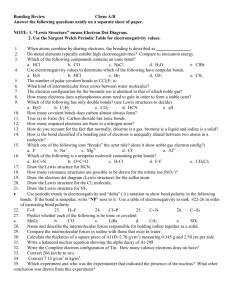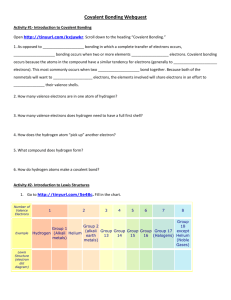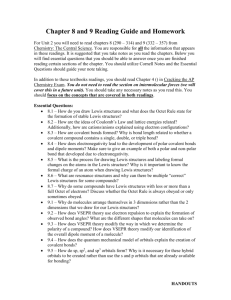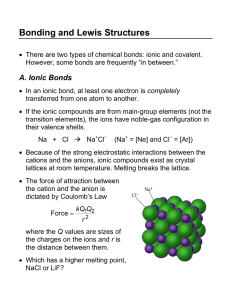Hints for Making Lewis Structures
advertisement
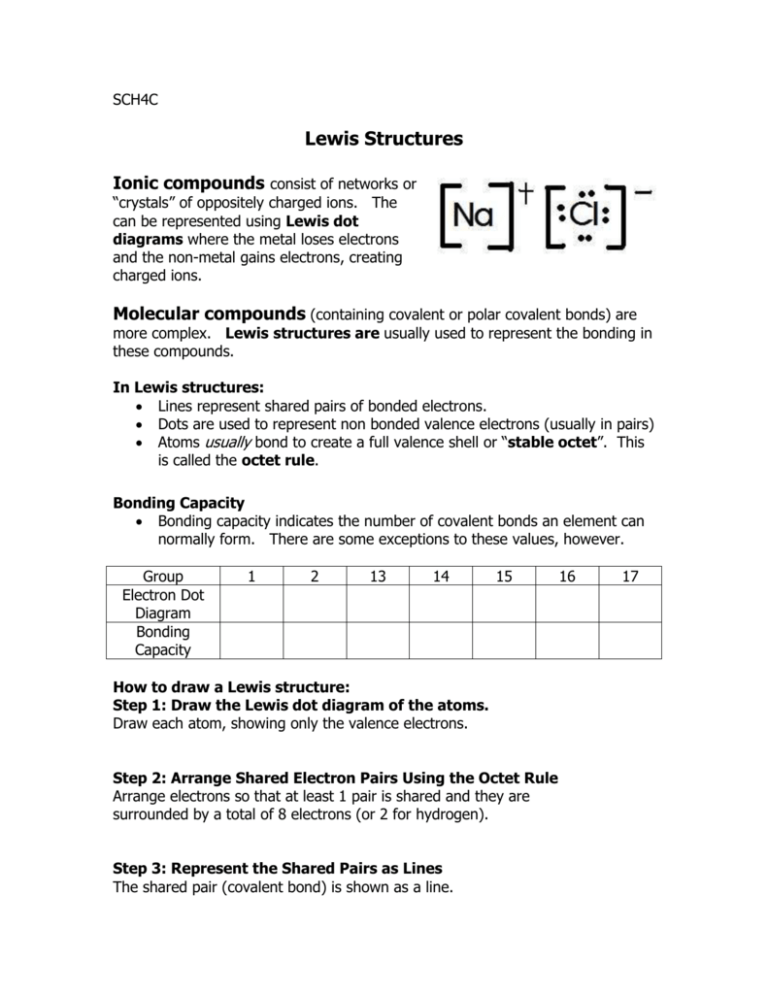
SCH4C Lewis Structures Ionic compounds consist of networks or “crystals” of oppositely charged ions. The can be represented using Lewis dot diagrams where the metal loses electrons and the non-metal gains electrons, creating charged ions. Molecular compounds (containing covalent or polar covalent bonds) are more complex. Lewis structures are usually used to represent the bonding in these compounds. In Lewis structures: Lines represent shared pairs of bonded electrons. Dots are used to represent non bonded valence electrons (usually in pairs) Atoms usually bond to create a full valence shell or “stable octet”. This is called the octet rule. Bonding Capacity Bonding capacity indicates the number of covalent bonds an element can normally form. There are some exceptions to these values, however. Group Electron Dot Diagram Bonding Capacity 1 2 13 14 15 How to draw a Lewis structure: Step 1: Draw the Lewis dot diagram of the atoms. Draw each atom, showing only the valence electrons. Step 2: Arrange Shared Electron Pairs Using the Octet Rule Arrange electrons so that at least 1 pair is shared and they are surrounded by a total of 8 electrons (or 2 for hydrogen). Step 3: Represent the Shared Pairs as Lines The shared pair (covalent bond) is shown as a line. 16 17 Hints for Making Lewis Structures: Consider the bonding capacity of each atom, and make sure you do not have more than that number of bonds (if possible). Make your molecule as symmetrical (balanced) as possible (e.g. O-C-O instead of C-O-O for carbon dioxide!) Hydrogen can ONLY form one bond. Oxygen always needs two bonds. Carbon ALMOST ALWAYS forms a total of four bonds. Substances containing single (unpaired) electrons are highly reactive. These are known as free radicals. Avoid leaving making a free radical in the Lewis structure if possible. Double and Triple Bonds Bonded atoms can share 1, 2 or 3 pairs of electrons. These are known as single, double and triple bonds. Cl2 O2 PH3 N2 C2H2 N2F2 SCH4C COVALENT AND POLAR COVALENT BONDING LEWIS STRUCTURES WORKSHEET PART A Each of the following molecules contain only single bonds between atoms. i) Predict the structure by comparing the bonding capacity of the atoms. ii) Draw the Lewis Structure for each molecule. a) Cl2 f) HCl k) CHCl3 p) CBr4 b) ICl g) CH4 l) S2Cl2 q) P2H4 c) H2O h) NF3 m) Br2 r) CF2Cl2 d) PH3 i) Cl2O n) SiF4 s) SeCl2 e) H2S2 j) C2H6 o) PCl3 t) C3H8 PART B Each of the following molecules may contain single, double or triple bonds. i) Predict the structure by comparing the bonding capacity of the atoms. ii) Draw the Lewis Structure for each molecule. 1) CS2 8) N2F4 15) SiO2 2) HCN 9) O2 16) N2H2 3) BrCl 10) NCl3 17) OF2 4) C2F2 11) H2S 18) C2FCl 5) HI 12) CH3Cl 19) C2Br2 6) CH2O 13) C2F4 20) BF3 7) C2F6 14) C4H10 CHALLENGES: Try to create a Lewis structure for these ones 1) methanol (CH3OH) (a poisonous alcohol) 2) cyclobutane (C4H8) (a circular hydrocarbon) 3) acetic acid (CH3COOH) (the sour taste in vinegar) 4) glycerol (C3H8O3) (Hint: 3 O-H bonds) (derived from fats and used in soaps)


